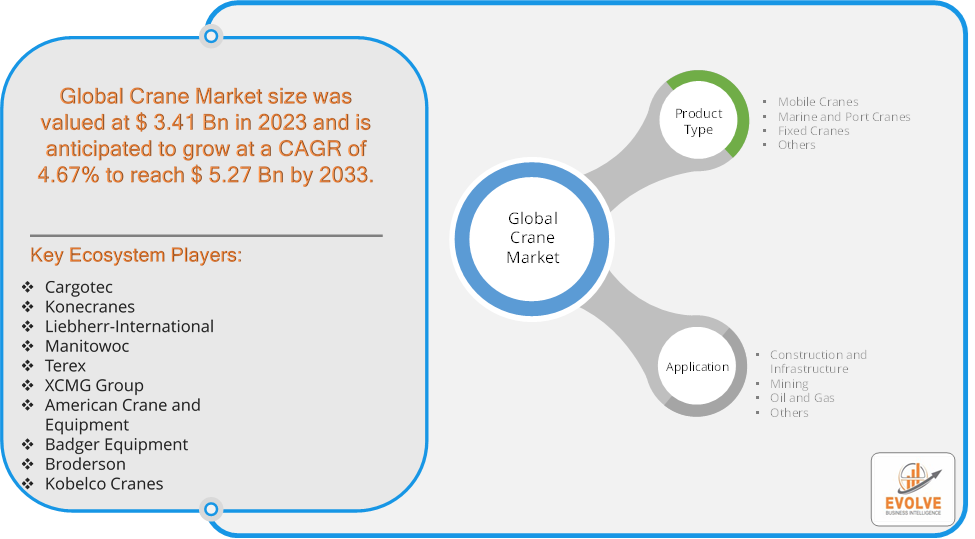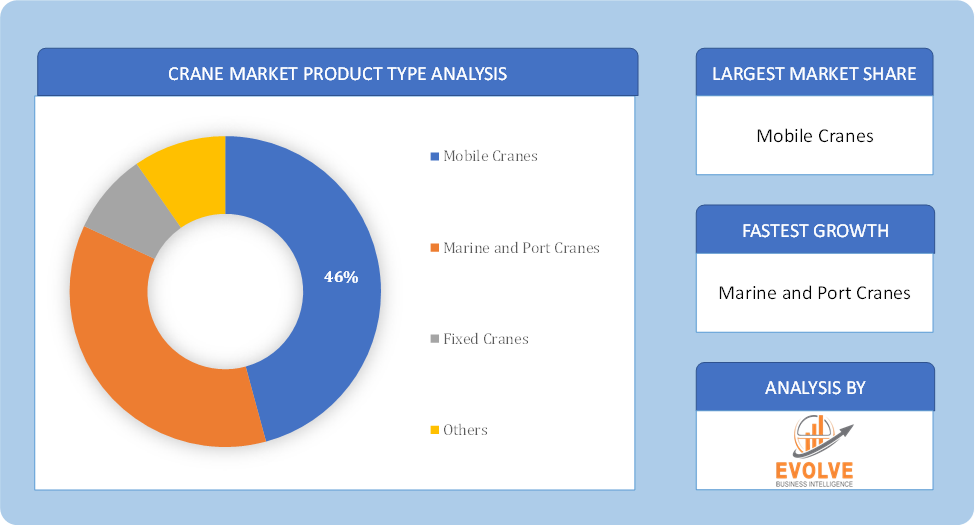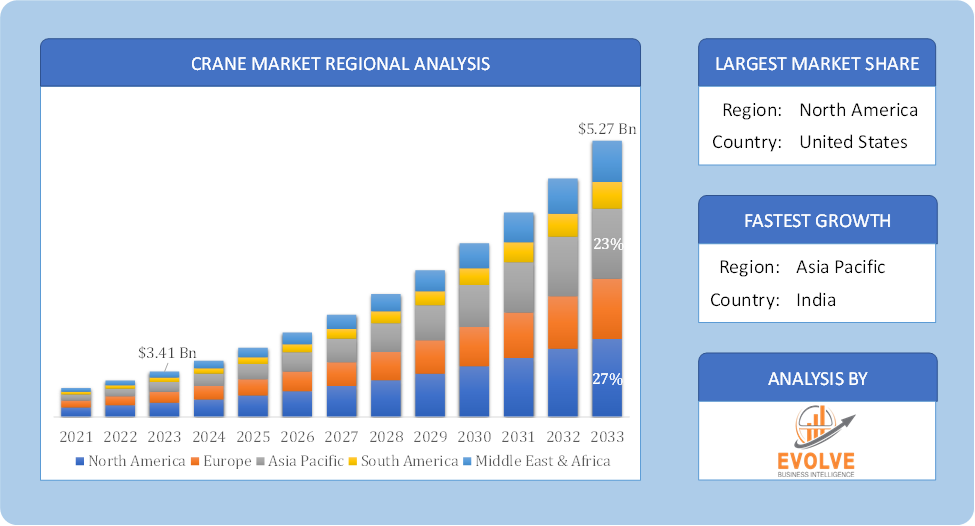Crane Market Analysis and Global Forecast 2023-2033
$1,390.00 – $5,520.00Price range: $1,390.00 through $5,520.00
Crane Market Research Report: Information By Product Type (Mobile Cranes, Marine and Port Cranes, Fixed Cranes, Others), By Application (Construction and Infrastructure, Mining, Oil and Gas, Others), and by Region — Forecast till 2033
Page: 172
[vc_row][vc_column width=”2/3″][vc_column_text text_larger=”no” woodmart_inline=”no”]
Crane Market Overview
The Crane Market Size is expected to reach USD 5.27 Billion by 2033. The Crane Market industry size accounted for USD 3.41 Billion in 2023 and is expected to expand at a compound annual growth rate (CAGR) of 4.67% from 2023 to 2033. The Crane Market encompasses the global industry involved in the design, manufacturing, and distribution of cranes. Cranes are heavy machinery used for lifting and moving heavy loads, typically in construction, manufacturing, transportation, and other industrial sectors.
Key factors influencing the Crane Market include economic growth, infrastructure development, technological advancements, and regulatory requirements. The market is driven by the increasing demand for construction activities, urbanization, and the need for efficient material handling solutions in various industries. Additionally, advancements in crane technology, such as automation and remote operation, are also contributing to market growth.
Global Crane Market Synopsis
 COVID-19 Impact Analysis
COVID-19 Impact Analysis
The COVID-19 pandemic had significant impacts on the Crane Market globally. The pandemic disrupted global supply chains, affecting the availability of raw materials, components, and finished cranes. Manufacturing and assembly processes were slowed or halted in many regions, leading to delays in crane deliveries and project timelines. Many construction projects were delayed or canceled due to lockdowns, travel restrictions, and economic uncertainties caused by the pandemic. This reduction in construction activity directly affected the demand for cranes, particularly in sectors such as commercial real estate, hospitality, and infrastructure. Economic downturns and reduced business activity during the pandemic led to financial uncertainties for companies involved in the crane market. This affected investment decisions and the willingness of businesses to commit to large capital expenditures on new cranes. The pandemic accelerated the adoption of technologies like remote monitoring, automation, and digital solutions in the crane industry. These innovations helped improve operational efficiency, safety, and maintenance practices during a period of reduced on-site workforce.
Crane Market Dynamics
The major factors that have impacted the growth of Crane Market are as follows:
Drivers:
Ø Construction Industry Growth
The construction sector is a major driver for cranes, encompassing residential, commercial, industrial, and institutional building projects. Increasing construction activities worldwide lead to higher demand for cranes for material handling and lifting purposes. Growth in manufacturing, mining, and energy sectors requires cranes for handling heavy machinery, raw materials, and finished products. Industrial expansion and modernization projects contribute significantly to crane market growth. Innovations in crane technology, such as automation, IoT integration, and digitalization, improve crane efficiency, safety, and operational capabilities. These advancements attract investments in newer, more advanced crane models.
Restraint:
- Perception of High initial investment and Maintenance
Cranes, especially large-scale ones, require substantial capital outlay for purchase or lease. This often proves to be a deterrent for small and medium-sized enterprises. Regular maintenance, inspections, and operator training add to the overall cost of ownership, making it a burden for some businesses. Construction and industrial activities, which are major consumers of cranes, are highly sensitive to economic fluctuations. A recession can significantly impact crane demand.
Opportunity:
⮚ Technological Advancements
The integration of advanced technologies such as automation, artificial intelligence (AI), Internet of Things (IoT), and digitalization presents a significant opportunity. These technologies can enhance crane efficiency, safety, and operational capabilities. For example, automated cranes can improve productivity by reducing manual intervention and downtime. IoT-enabled cranes can provide real-time data on performance and maintenance needs, optimizing operations and reducing operating costs.
Crane Market Segment Overview
 By Product Type
By Product Type
Based on Product Type, the market is segmented based on Mobile Cranes, Marine and Port Cranes, Fixed Cranes and Others. Mobile Cranes segment dominant the market. Modern mobile cranes come equipped with advanced hydraulic systems and controls that enable them to lift heavy loads with great precision, often rivalling or even surpassing the capabilities of their stationary counterparts. With cities expanding and infrastructure undergoing constant renewal, the demand for cranes that can easily navigate through congested urban landscapes has skyrocketed. Furthermore, technological advancements have added layers of automation, real-time monitoring, and other smart features to the newer models of mobile cranes, making them even more efficient and safe to operate.
By Application
Based on Application, the market segment has been divided into the Construction and Infrastructure, Mining, Oil and Gas and Others. The construction segment dominated the market. The construction of high-rise buildings is also gaining rapid pace due to growing urbanization. Cranes are used to lift and transport heavy construction materials in the construction of high-rise buildings. Thus, the rise in the construction of high-rise buildings is also anticipated to drive market growth.
Global Crane Market Regional Analysis
Based on region, the global Crane Market has been divided into North America, Europe, Asia-Pacific, the Middle East & Africa, and Latin America. North America is projected to dominate the use of the Crane Market followed by the Asia-Pacific and Europe regions.
 Crane North America Market
Crane North America Market
North America holds a dominant position in the Crane Market. The U.S. crane market benefits from robust infrastructure investments, including roads, bridges, and commercial construction. Technological advancements in crane equipment are prevalent, with a strong focus on safety and efficiency.
Crane Asia-Pacific Market
The Asia-Pacific region has indeed emerged as the fastest-growing market for the Crane Market industry. China dominates the Asia-Pacific crane market with extensive infrastructure development, urbanization, and manufacturing growth. High-rise construction and large-scale infrastructure projects fuel demand for various types of cranes. Also, India region had Rapid urbanization and government initiatives like “Make in India” boost the crane market, especially in construction and infrastructure sectors.
Competitive Landscape
The global Crane Market is highly competitive, with numerous players offering a wide range of software solutions. The competitive landscape is characterized by the presence of established companies, as well as emerging startups and niche players. To increase their market position and attract a wide consumer base, the businesses are employing various strategies, such as product launches, and strategic alliances.
Prominent Players:
- Cargotec
- Konecranes
- Liebherr-International
- Manitowoc
- Terex
- XCMG Group
- American Crane and Equipment
- Badger Equipment
- Broderson
- Kobelco Cranes
Key Development
In December 2021: XCMG launched the world’s first truck crane with hybrid technology, XCMG XCT25 EV, which has recently become popular due to the crane’s patented product technology platform. The 25-ton hybrid crane product has four operating modes: plug-in, plug-in hybrid, pure electricity, and pure oil.
In September 2023, Hiab, part of Cargotec, launched the new HIAB iQ.958 HiPro heavy loader crane with the new advanced operating system SPACEevo to improve productivity and safer operation. Due to its design, it delivers an excellent lift-to-weight ratio.
Scope of the Report
Global Crane Market, by Product Type
- Mobile Cranes
- Marine and Port Cranes
- Fixed Cranes
- Others
Global Crane Market, by Application
- Construction and Infrastructure
- Mining
- Oil and Gas
- Others
Global Crane Market, by Region
- North America
- US
- Canada
- Mexico
- Europe
- UK
- Germany
- France
- Italy
- Spain
- Benelux
- Nordic
- Rest of Europe
- Asia Pacific
- China
- Japan
- South Korea
- Indonesia
- Austalia
- Malaysia
- India
- Rest of Asia Pacific
- South America
- Brazil
- Argentina
- Rest of South America
- Middle East & Africa
- Saudi Arabia
- UAE
- Egypt
- South Africa
- Rest of Middle East & Africa
| Parameters | Indicators |
|---|---|
| Market Size | 2033: USD 5.27 Billion |
| CAGR (2023-2033) | 4.67% |
| Base year | 2022 |
| Forecast Period | 2023-2033 |
| Historical Data | 2021 (2017 to 2020 On Demand) |
| Report Coverage | Revenue Forecast, Competitive Landscape, Growth Factors, and Trends |
| Key Segmentations | Product Type, Application |
| Geographies Covered | North America, Europe, Asia-Pacific, South America, Middle East, Africa |
| Key Vendors | Cargotec, Konecranes, Liebherr-International, Manitowoc, Terex, XCMG Group, American Crane and Equipment, Badger Equipment, Broderson and Kobelco Cranes. |
| Key Market Opportunities | · Technological Advancements |
| Key Market Drivers | · Construction Industry Growth |
REPORT CONTENT BRIEF:
- High-level analysis of the current and future Crane Market trends and opportunities
- Detailed analysis of current market drivers, restraining factors, and opportunities in the future
- Crane Market historical market size for the year 2021, and forecast from 2023 to 2033
- Crane Market share analysis at each product level
- Competitor analysis with detailed insight into its product segment, Government & Defense strength, and strategies adopted.
- Identifies key strategies adopted including product launches and developments, mergers and acquisitions, joint ventures, collaborations, and partnerships as well as funding taken and investment done, among others.
- To identify and understand the various factors involved in the global Crane Market affected by the pandemic
- To provide a detailed insight into the major companies operating in the market. The profiling will include the Government & Defense health of the company’s past 2-3 years with segmental and regional revenue breakup, product offering, recent developments, SWOT analysis, and key strategies.
[/vc_column_text][vc_column_text woodmart_inline=”no” text_larger=”no”]
Frequently Asked Questions (FAQ)
[sp_easyaccordion id=”73173″][/vc_column_text][/vc_column][vc_column width=”1/3″][vc_column_text text_larger=”no” woodmart_inline=”no”]
[html_block id=”3961″][/vc_column_text][vc_wp_text]
Press Release
[rpwe limit=”10″ thumb=”true”][/vc_wp_text][/vc_column][/vc_row]


 Crane North America Market
Crane North America Market